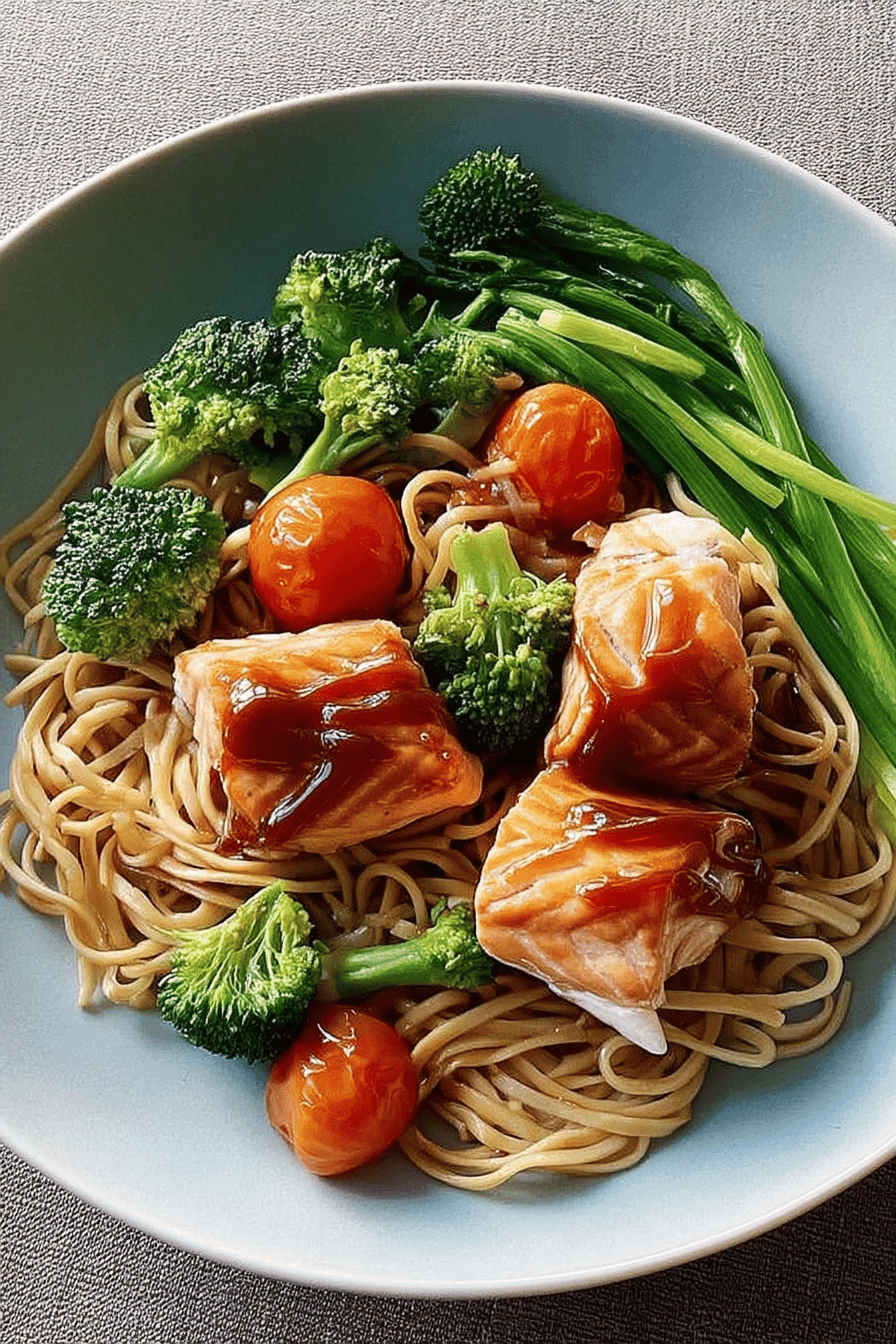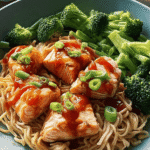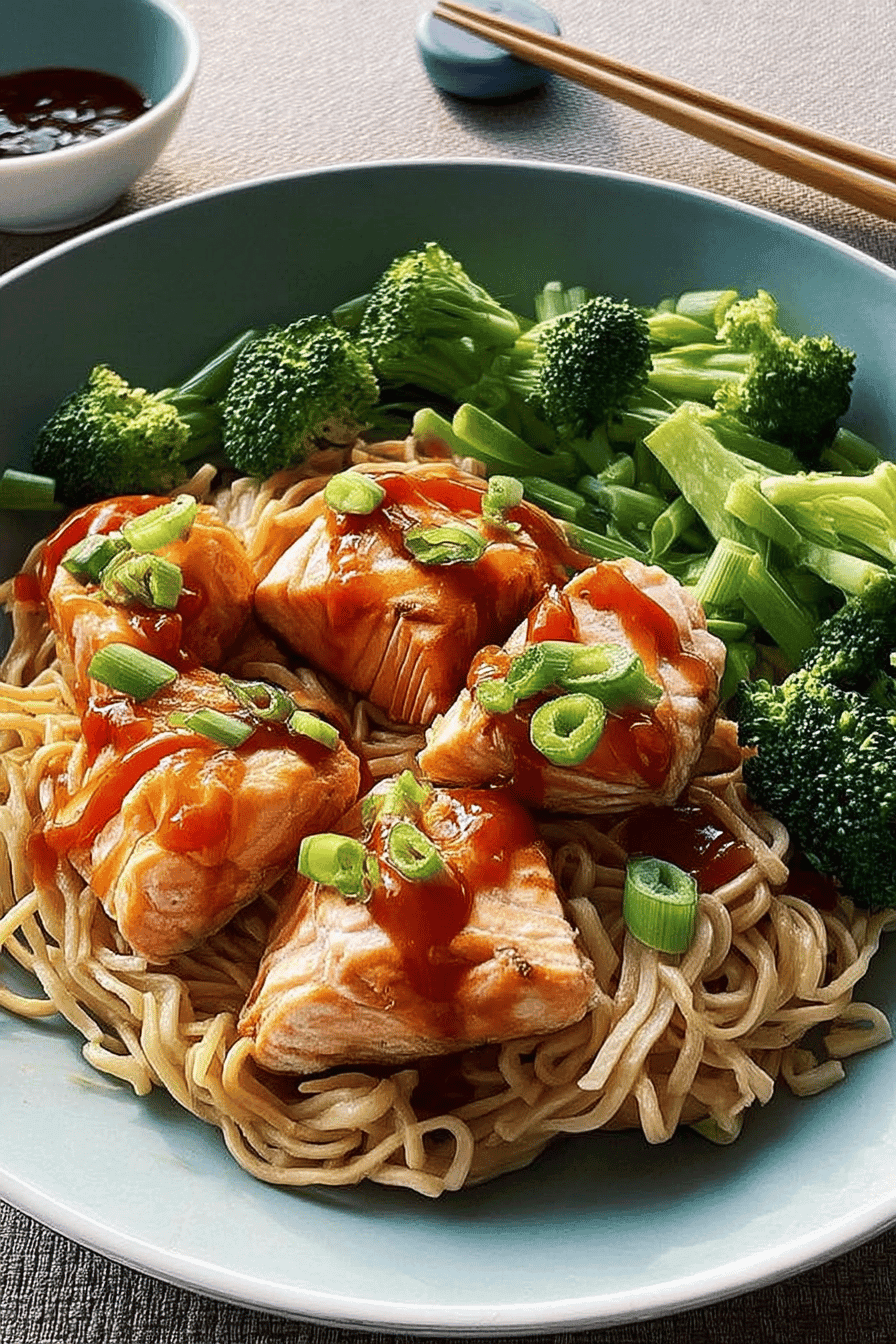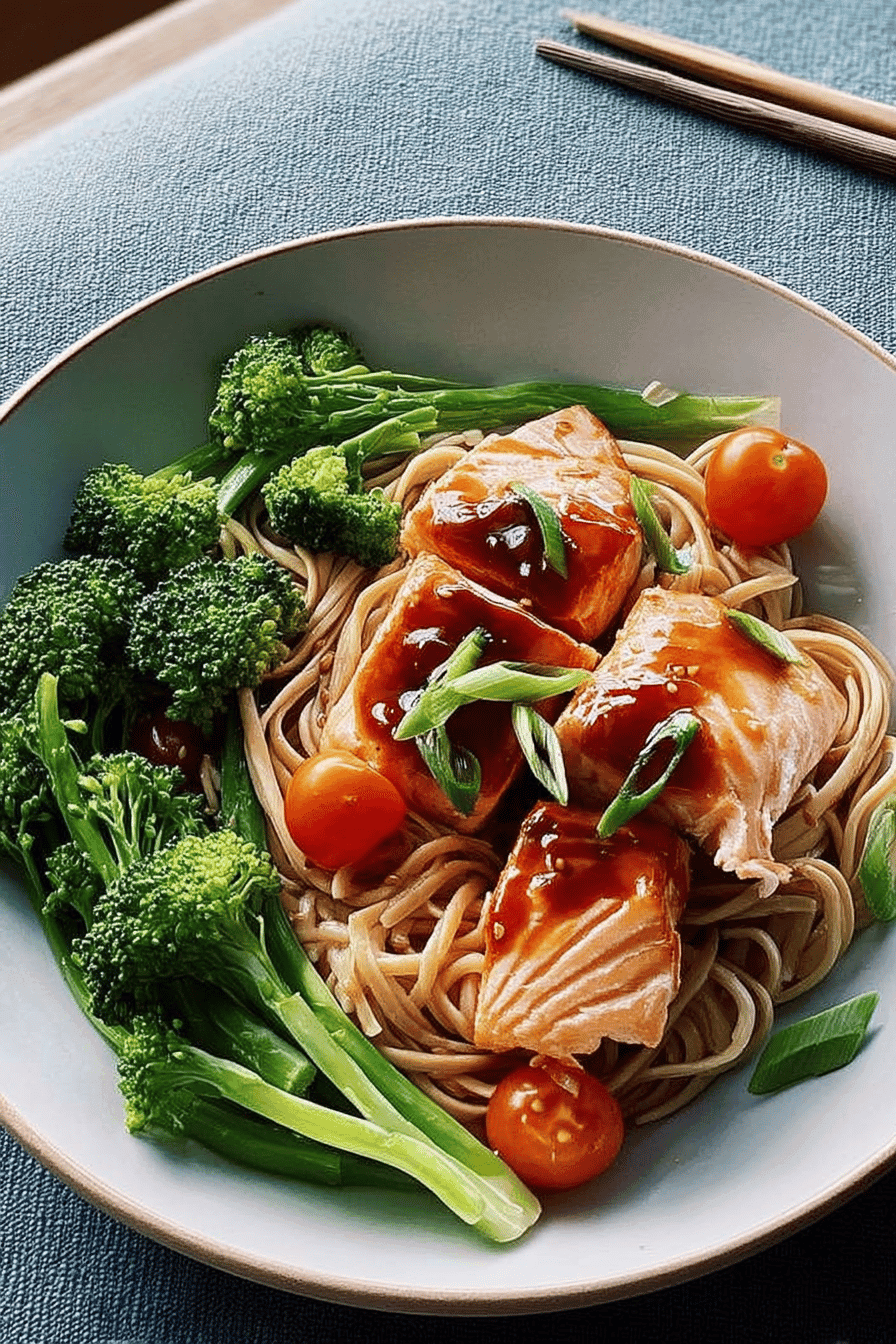Benefits and Advantages of hoisin salmon noodles
Hoisin salmon noodles combine flavor, nutrition, and convenience into one satisfying dish that appeals to home cooks and food enthusiasts alike. This recipe serves 4 and can be prepared in under 30 minutes, making it an excellent choice for busy parents, students, and working professionals seeking a quick, wholesome meal without sacrificing taste.
The salmon fillets used provide a robust source of omega-3 fatty acids and protein, which support heart health and brain function. Paired with the savory sweetness of hoisin sauce, the dish delivers an exciting flavor profile without overwhelming the palate.
Balancing lean protein, healthy fats, and complex carbohydrates from medium egg noodles or noodles of your choice, this meal sustains energy and satiety. The addition of vegetables like cherry tomatoes, broccoli, or Brussels sprouts enhances fiber and micronutrient intake while keeping the dish naturally free from nuts, lactose, dairy, and eggs, accommodating various dietary restrictions.
“Hoisin salmon noodles are a flavorful and nutritious meal that’s simple enough for weeknights and impressive enough to share with guests.”
Its adaptable nature allows for tailored substitutions based on dietary needs or ingredient availability, such as swapping noodles or using different vegetables. Furthermore, this dish combines quick preparation and nutrient density, making it very suitable for health-conscious individuals and busy lifestyles.
Summary of Benefits
| Aspect | Benefit |
|---|---|
| Nutrition | Rich in omega-3, protein, fiber, and vitamins |
| Preparation | Quick to prepare in under 30 minutes |
| Flavor | Balanced sweet and savory with hoisin glaze |
| Dietary Inclusivity | Free from nuts, dairy, eggs; easily modified |
| Convenience | Flexible with various noodle and vegetable options |
Jump To
- 1. Benefits and Advantages of hoisin salmon noodles
- 2. Essential Ingredients for hoisin salmon noodles
- 3. Dietary Substitutions to Customize Your hoisin salmon noodles
- 4. How to Prepare the Perfect Hoisin Salmon Noodles: Step-by-Step Guide
- 5. Advanced Tips and Variations
- 6. How to Store Hoisin Salmon Noodles: Best Practices
- 7. Nutritional Value of Hoisin Salmon Noodles
- 8. FAQs: Frequently Asked Questions About Hoisin Salmon Noodles
- 9. hoisin salmon noodles
Essential Ingredients for hoisin salmon noodles
To prepare this delicious hoisin salmon noodles recipe for four servings, make sure you have the following ingredients ready. Each plays a vital role in achieving the harmony of flavors and textures described.
- 4 salmon fillets (125g / 4oz each, skin on)
- 2 to 6 heaped tablespoons hoisin sauce (adjust according to taste; provides sweet and savory glaze)
- 150g (5½oz) halved cherry tomatoes or 1 bunch chopped broccoli with 8-16 halved Brussels sprouts (adds freshness and roasted vegetable flavor)
- 140g (5oz) medium egg noodles or substitute with soba, angel hair, spaghetti, or instant ramen noodles (approximately 340g / ¾ lb if fresh)
- Olive oil, garlic, salt, and freshly ground black pepper (for seasoning vegetables and salmon)
- Optional garnishes and seasonings:
- 4 sliced green onions
- ½ cup chopped cilantro
- ¼ cup toasted sesame seeds
- Dark soy sauce for serving
These elements combine to create a vibrant, balanced dish that is quick to prepare yet impressive in flavor. The choice of noodles can be varied according to preference or dietary needs, and the vegetables provide essential vitamins and texture contrast.
Ingredient Overview Table
| Ingredient | Quantity | Role in Recipe |
|---|---|---|
| Salmon fillets | 4 fillets, 125g each | Main protein, rich in omega-3 |
| Hoisin sauce | 2 to 6 tbsp | Glaze and flavor enhancer |
| Cherry tomatoes or broccoli + Brussels sprouts | 150g / 1 bunch + 8-16 sprouts | Vegetables for freshness and nutrition |
| Medium egg noodles (or substitutes) | 140g dry, 340g fresh approx. | Carbohydrate base, texture |
| Green onions, cilantro, sesame seeds | Optional garnishes | Flavor, color, texture accents |
| Dark soy sauce | To taste | Additional seasoning option |
For tips on cooking noodles perfectly, visit this comprehensive guide.
Dietary Substitutions to Customize Your hoisin salmon noodles
One standout feature of hoisin salmon noodles is how easily the recipe adapts to various dietary preferences and ingredient availability. Customizing the dish ensures that everyone can enjoy it according to their needs without losing the essence of its delicious flavors.
Protein Alternatives
- For seafood allergies or preferences: Replace salmon with firm tofu or tempeh for a vegetarian or vegan option. Chicken breast is another alternative for those who prefer poultry. These swaps maintain protein content and texture diversity.
- Vegan adaptation: Use vegan-certified hoisin sauce to avoid animal-derived ingredients.
Noodle Substitutions
- Gluten-free option: Substitute standard egg noodles with certified gluten-free rice noodles or shirataki noodles to reduce carbohydrates and gluten exposure.
- Low-carb alternative: Use spiralized zucchini or shirataki noodles instead of traditional noodles for lower calorie and carb content.
Vegetable Variations
- Boost fiber and nutrient density by increasing vegetables such as bell peppers, carrots, or frozen peas.
- Choose vegetables based on seasonality or personal preference to keep the dish fresh and exciting.
Cooking and Seasoning Adaptations
- Cooking salmon: Besides baking or pan-searing, grilling or broiling the salmon are healthy alternatives that add smoky flavor.
- Seasoning swaps: Use tamari instead of soy sauce for gluten sensitivity, or coconut aminos for soy-free diets.
- Reduce oil usage: To lower fat content without compromising flavor, reduce the amount of added oil and favor steaming or roasting vegetables.
Flexibility in ingredients and preparation methods makes hoisin salmon noodles suitable for diverse dietary needs, from gluten-free to vegan and low-calorie diets.
With these substitutions, you can make hoisin salmon noodles your own while maintaining a delicious and balanced meal. For more home-cooked inspired recipes that fit various dietary goals, feel free to check out this popular chicken pasta recipe and discover how simple modifications create versatile dishes.
How to Prepare the Perfect Hoisin Salmon Noodles: Step-by-Step Guide
This recipe serves 4 and can be prepared in under 30 minutes, ideal for busy weeknights or when you want a flavorful, nutritious meal fast.
Step 1: Gather and Prep Ingredients
- Preheat your oven to 220°C (200°C fan/Gas 7) or 425°F.
- Slice green onions, mince garlic, grate ginger, and chop cilantro for garnish.
- Prepare your vegetables: halved cherry tomatoes or a mix of chopped broccoli and halved Brussels sprouts.
- Choose your noodles: medium egg noodles (140g) or substitutes like soba, angel hair, spaghetti, or instant ramen noodles (approximately 340g if fresh).
Step 2: Cook the Salmon
Place 4 salmon fillets (125g or 4oz each, skin on) in a foil-lined ovenproof dish, skin-side down. Brush generously with 2 to 6 heaped tablespoons of hoisin sauce, spacing fillets at least 5cm apart.
Arrange prepared vegetables around the salmon, tossing with olive oil, garlic, salt, and pepper.
Bake for 15 minutes or until salmon is cooked through. For a pan-seared option, cook salmon skin-side down in olive oil for 3-5 minutes, flip, then broil briefly with a sprinkle of sugar for caramelization.
Step 3: Cook the Noodles and Vegetables
Boil salted water and cook noodles according to package instructions:
- Egg noodles: 1 minute
- Soba or ramen: under 3 minutes
Stir frequently to separate strands and ensure noodles remain al dente. Add broccoli or frozen peas in the last minutes of cooking, then drain and rinse if desired.
Step 4: Prepare the Dressing and Toss
Whisk together:
- Hoisin sauce
- Reduced-sodium soy sauce
- Toasted sesame oil
- Rice vinegar
- Lime zest and juice
- Grated ginger
- Honey or sugar
- Minced garlic
- Optional crushed red pepper flakes
Toss cooked noodles and vegetables with this dressing for full, vibrant flavor.
Step 5: Assemble and Garnish
Plate noodles and veggies evenly among four warm plates, top with salmon and roasted tomatoes or vegetables.
Sprinkle with sliced green onions, chopped cilantro, toasted sesame seeds, freshly ground black pepper, and serve with optional dark soy sauce for extra seasoning.
Tip: Thinly slice spring onions to sprinkle over salmon before cooking for an aromatic boost.
Advanced Tips and Variations
Key Tips for Best Results
- Fresh Ingredients: Use fresh salmon and vegetables for maximum flavor.
- Don’t Overcook: Keep salmon moist by avoiding overcooking and noodles al dente by following precise cooking times.
- Add Crunch: Toasted sesame seeds or crushed peanuts add texture and nutty aroma.
- Lime Juice Splash: Add just before serving to brighten the sweet-savory notes.
Variations to Try
| Variation | Description | Flavor/Texture Impact |
|---|---|---|
| Different Noodles | Use soba, whole wheat, or angel hair noodles | Adds variety in texture and nutrition |
| Protein Swap | Replace salmon with smoked salmon or steak | Offers smoky depth or richer meatiness |
| Herb Substitution | Try basil or mint instead of cilantro | Introduces fresh, aromatic notes |
| Spicy Kick | Add fresh chili slices or chili oil | Provides heat and complexity |
| Custom Sauce | Mix hoisin with homemade plum sauce | Creates unique sweet-savory blends |
These suggestions let you tailor the dish to your taste preferences and dietary needs.
How to Store Hoisin Salmon Noodles: Best Practices
Proper storage is crucial to maintain the recipe’s flavor, texture, and food safety.
- Refrigerate promptly: Store leftovers in an airtight container within two hours of cooking.
- Consume soon: Eat refrigerated portions within 2 to 3 days for best taste and safety.
- Freeze wisely: For longer storage, freeze noodles separate from garnishes in labeled freezer-safe containers or bags.
- Thaw carefully: Thaw overnight in the refrigerator before reheating gently.
- Reheat properly: Use a microwave or stovetop with a splash of water or broth to keep moisture. Avoid repeated reheating to prevent dryness.
Handling leftovers properly preserves the quality of hoisin salmon noodles for later enjoyment.
Nutritional Value of Hoisin Salmon Noodles
Each serving of hoisin salmon noodles delivers a balanced mix of nutrients important for overall wellness:
| Nutrient | Amount Per Serving | Health Benefits |
|---|---|---|
| Calories | 439-549 kcal | Supports daily energy needs for active individuals |
| Protein | Approximately 32g | Helps repair tissues and supports muscle growth, largely from salmon |
| Carbohydrates | About 32g (including 7g sugars) | Provides sustained energy from noodles and vegetables |
| Fat | Approximately 19g (including 3.5g saturated fat) | Healthy fats from salmon and sesame oil support brain and heart health |
| Fiber | 4.5g | Aids digestive health from vegetables |
| Salt | 1.2g | Moderate sodium level from sauces, manageable in balanced diets |
This dish is naturally free from nuts, lactose, dairy, and eggs, making it suitable for many dietary preferences.
For more about the health benefits of salmon and the nutritional value of hoisin sauce, visit these helpful resources.

FAQs: Frequently Asked Questions About Hoisin Salmon Noodles
How do I make hoisin salmon noodles at home?
To make hoisin salmon noodles, start by cooking your choice of noodles (soba, rice, or egg noodles) according to package instructions. Meanwhile, pan-sear salmon fillets seasoned with salt and pepper until cooked through. In a separate pan, prepare the sauce by combining hoisin sauce, soy sauce, minced garlic, and a splash of rice vinegar. Toss the cooked noodles in the sauce, top with the salmon, and garnish with sliced green onions and sesame seeds. This quick recipe delivers a flavorful dish in about 30 minutes.
What type of noodles work best with hoisin salmon?
Soba noodles, rice noodles, or egg noodles all pair well with hoisin salmon. Soba noodles offer a nutty flavor and firm texture that complements the sweet and tangy hoisin sauce. Rice noodles create a lighter dish, preferred in many Asian recipes. Egg noodles provide a richer taste and softer texture. Choose the noodle type based on your preference and dietary needs; cooking times may vary, so follow package directions for best results.
Can I substitute ingredients in hoisin salmon noodles for dietary restrictions?
Yes, hoisin salmon noodles can be adapted for various dietary needs. For gluten-free options, use gluten-free hoisin sauce and rice noodles instead of wheat-based noodles. If you’re avoiding soy, consider substituting the soy sauce with coconut aminos and choose a hoisin sauce without soy ingredients. For a low-carb alternative, use spiralized vegetables or shirataki noodles. These swaps maintain flavor while fitting your dietary preferences.
How should I store and reheat leftovers of hoisin salmon noodles?
Store leftover hoisin salmon noodles in an airtight container in the refrigerator for up to 2 days. When reheating, gently warm the noodles and salmon in a skillet over medium heat to prevent the fish from drying out. You can add a splash of water or broth to keep the noodles moist. Avoid microwaving for prolonged periods, as it may alter texture and flavor. Always ensure the salmon is heated through before serving.
What are some easy side dishes to serve with hoisin salmon noodles?
Light sides complement the rich flavors of hoisin salmon noodles. Steamed or stir-fried vegetables like bok choy, snap peas, or broccoli add freshness and crunch. A simple cucumber salad with rice vinegar and sesame seeds provides a crisp contrast. You can also serve miso soup or edamame as a starter for a balanced meal. These sides enhance the dish without overpowering its distinctive taste.

hoisin salmon noodles
- Total Time: 25 minutes
- Yield: Serves 4
- Diet: Nut-free, Lactose-free, Dairy-free, Egg-free
Description
🐟 This hoisin salmon noodles recipe combines rich flavors and a colorful presentation for a delicious and satisfying meal.
🍜 Quick to prepare with fresh ingredients, it’s perfect for a healthy weeknight dinner that packs a protein punch.
Ingredients
– 4 salmon fillets (125g / 4oz each, skin on)
– 2 to 6 heaped tablespoons hoisin sauce
– 150g (5½oz) halved cherry tomatoes or 1 bunch chopped broccoli with 8-16 halved Brussels sprouts
– 140g (5oz) medium egg noodles or substitute with soba, angel hair, spaghetti, or instant ramen noodles (approximately 340g / ¾ lb if fresh)
– Olive oil, garlic, salt, and freshly ground black pepper
– 4 sliced green onions
– ½ cup chopped cilantro
– ¼ cup toasted sesame seeds
– Dark soy sauce for serving
Instructions
Step 1: Gather and Prep Ingredients
* Preheat your oven to 220°C (200°C fan/Gas 7) or 425°F.
* Slice green onions, mince garlic, grate ginger, and chop cilantro for garnish.
* Prepare your vegetables: halved cherry tomatoes or a mix of chopped broccoli and halved Brussels sprouts.
* Choose your noodles: medium egg noodles (140g) or substitutes like soba, angel hair, spaghetti, or instant ramen noodles (approximately 340g if fresh).
Step 2: Cook the Salmon
Place 4 salmon fillets (125g or 4oz each, skin on) in a foil-lined ovenproof dish, skin-side down. Brush generously with 2 to 6 heaped tablespoons of hoisin sauce, spacing fillets at least 5cm apart.
Arrange prepared vegetables around the salmon, tossing with olive oil, garlic, salt, and pepper.
Bake for 15 minutes or until salmon is cooked through. For a pan-seared option, cook salmon skin-side down in olive oil for 3-5 minutes, flip, then broil briefly with a sprinkle of sugar for caramelization.
Step 3: Cook the Noodles and Vegetables
Boil salted water and cook noodles according to package instructions:
* Egg noodles: 1 minute
* Soba or ramen: under 3 minutes
Stir frequently to separate strands and ensure noodles remain al dente. Add broccoli or frozen peas in the last minutes of cooking, then drain and rinse if desired.
Step 4: Prepare the Dressing and Toss
Whisk together:
* Hoisin sauce
* Reduced-sodium soy sauce
* Toasted sesame oil
* Rice vinegar
* Lime zest and juice
* Grated ginger
* Honey or sugar
* Minced garlic
* Optional crushed red pepper flakes
Toss cooked noodles and vegetables with this dressing for full, vibrant flavor.
Step 5: Assemble and Garnish
Plate noodles and veggies evenly among four warm plates, top with salmon and roasted tomatoes or vegetables.
Sprinkle with sliced green onions, chopped cilantro, toasted sesame seeds, freshly ground black pepper, and serve with optional dark soy sauce for extra seasoning.
Notes
🌿 Thinly slice spring onions to scatter over the salmon before cooking for added freshness and aroma.
⏳ Avoid overcooking the noodles to keep their ideal al dente texture and enhance the dish’s overall bite.
🥩 Feel free to substitute the noodles or swap salmon for steak to customize the recipe to your preference.
- Prep Time: 10 minutes
- Marinating Time: 0 minutes
- Cook Time: 15 minutes
- Category: Main Course
- Method: Baking and Boiling
- Cuisine: Asian Fusion
Nutrition
- Serving Size: 1 plate
- Calories: 494 kcal
- Sugar: 7 g
- Sodium: 1.2 g
- Fat: 19 g
- Saturated Fat: 3.5 g
- Unsaturated Fat: 15 g
- Trans Fat: 0 g
- Carbohydrates: 32 g
- Fiber: 4.5 g
- Protein: 32 g
- Cholesterol: 70 mg
Keywords: Hoisin Salmon, Noodles, Caramelized Glaze, Sesame Ramen


